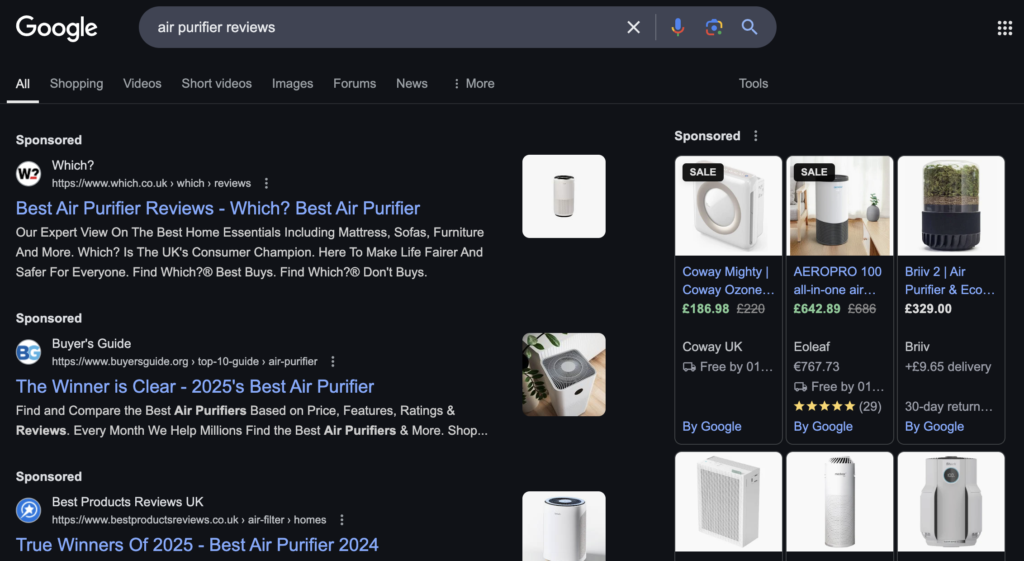Air Purifier Reviews by Ed Sherbenou
Consumer Alert: Please Read This Before Purchasing an Air Cleaner
Air Cleaner buyers face a maze of advertising hype and questionable marketing practices.
Air purifier reviews often emphasize selling points in a one sided manner.
Here lie both danger and opportunity.
The danger may go beyond just wasted time and money: some air purifiers are actually unhealthy.
A perfect opportunity to improve our health and well being also exists. I believe we can all benefit from a plan to improve indoor air quality, which includes carefully chosen purifiers.
The majority of people buying purifiers have wasted their money, naively buying over-hyped products they saw on TV infomercials. Many of these folks go straight from viewing the TV ads to the purchase without careful product comparison.
Many air cleaners have been sold via multilevel marketing, although MLM is currently in decline.
Machines sold through these marketing channels do little cleaning and even less to improve health.
The ads cost millions, so the consumers pay even more for the “stylish” products.
Give these vendors credit for running a clever marketing campaign, but don’t give them your credit card!
Objective Information?
A second group of buyers researches diligently, only to be lead astray by web content which is deliberately spurious, misleading, offers an incomplete view, or is simply incompetent.
They enter “air purifier reviews” into their favorite search engine, looking for information.
Their search lists over 1,000 air cleaners with a bewildering array of makes, models, and cleaning technologies.

The vast majority of these products lack the market penetration required for deep and broad product support and reliable customer service.
While there are many good purification vendors and honest air cleaner reviewers, clicking most search engine results is an annoying waste of time.
Worse yet, most “reviews” are posted on sites selling the air cleaners they rate the highest. Some even have hidden proprietary interests in the machines their site evaluates.
In recent years, former marketing-over-substance leaders Oreck and Sharper Image have fallen by the wayside, but the rise of imports from China, most rebranded with only cryptic product background, has kept the consumer in the dark.
In the recession of 2009, many dealers closed, hundreds of models were discontinued, support evaporated, warranty claim payouts shrank, and replacement filters dried up.
In 2020, the market consolidation continues.
Buyers should beware “deals” on discontinued or obsolete equipment and obscure builders/vendors.
Established “American” brands are increasingly being licensed to firms operating in Asia.
These are then re-engineered for mainland China manufacture and reintroduced in the US market as the familiar brand.
Deliberately obscure jargon abounds in air cleaning world, with confusing acronyms everywhere; HEPA, CADR, VOC, AHAM, and more.
By clicking Air-Purifier-Power.com you have joined the third group, the informed consumers seeking power over their own lives.
Let’s work smarter and harder. It’s time we cleaned the air along the Information Superhighway.
Welcome to the Web’s Best Air Purifier Reviews
My name is Ed.
I’ve been a ceaseless campaigner against dangerous products most of my adult life.
My detailed knowledge was gained the hard way: through a 40 year struggle against multiple chemical sensitivities (MCS), chronic fatigue (CFIDS) and Fibromyalgia.

I smell an idling diesel, a cigarette, or excess perfume on either gender, from far away.
I must avoid these airborne toxins, just to keep the health gains I have made.
My first attempt to purify air was a simple ionizer, mail-ordered from the then-embryonic Sharper Image, after viewing a glossy 1977 magazine ad.
I bought my first purifier without any research – there were literally no consumer resources dedicated to air quality, and the internet didn’t exist.
There were no air purifier reviews.
But there was a universal belief, cultivated by propaganda since the 1950’s, in “progress through chemistry”.
This blinded many, especially in the scientific and medical institutions, to dangers that common sense should have revealed.
Since that time I have learned a key truth about wellness, which is what makes this site different:
“What you can’t see does hurt you.”
I believe that allergy, asthma, MCS, and many other health problems have subtle environmental causes.
Everyday exposures to unseen pollutants in our air, water, and food, as well as rapidly evolving microorganisms, are more important than the dust we can see and odors we can smell.
Everyone has seen dust particles dancing in a shaft of sunlight in their home.
The dirty little secret of the industry is this:
Most purifiers cannot completely remove fine lung-penetrating particles,
lingering odors, toxic volatile gasses, or secondhand smoke.
So much of the air cleaner industry concentrates on products which simply make things look clean by collecting large sized particles – just visible dust!
Hey, any average HEPA-filtered vacuum cleaner can do that!
And this leads us to the second important insight – a HEPA filter is expired when it fills with enough particles to obstruct airflow, not when it is simply discolored or an arbitrary time limit is reached.
HEPAs are designed to retain tiny .3 micron sized particles.
If we have poor prefiltering, as many inexpensive air cleaners do, the main filter will fill rapidly with 5 to 20 micron large dust and need frequent replacement.
This allows lower quality air cleaners to be sold as loss leaders for high-priced filter replacements.
Many of these bargain air purifiers have long term costs of ownership higher than some premium marques.
The third key to air purifier success is discount the industry’s room size ratings – most users are over-installing their air purifiers, falsely believing this is economical.
Installed in too large a space, most air cleaners will fail to lower pollutant levels appreciably.
Together we can see beyond the industry’s smokescreen and seek effective solutions to these unseen dangers.
A systematic approach, starting with locating and removing pollution sources, as well as adequate ventilation, should accompany the use of air cleaners.
Ed passed away in the arms of his loving wife on December 26, 2015, at their home in Elgin, Texas.
He lives on through his contributions to the web’s air quality section. Air Purifier Power is now managed by the team at HouseFresh, which was heavily inspired by his work in air purification.
What’s Inside an Air Purifier?
We need to analyze what’s inside air purifiers, beyond the stylishness of a typical plastic case, which gets the emphasis in most reviews.
In the photo, I have disassembled a favorite air purifier, a 2005 model Sharp Plasmacluster that still runs perfectly.
It’s air purifier cleaning time, and the arrows show accumulated dirt.

The blue arrow points to the dusty washable carbon filter bag, red to the air cleaner’s permanent prefilter, and yellow to the still-clean HEPA filter.
This air cleaner has run every day since 2005 without needing a HEPA filter replacement.
To control operating costs, I have refilled the carbon filter bag ($15) and keep coarse visible dust out of the HEPA by using additional prefilter layers and frequently cleaning the fiberglass prefilter screen.
Again, the “secret” to long HEPA filter life is keeping particles above 5 microns, large dust, from filling the gaps in a filter intended for tiny sub-micron particles.
I do this by modifying the filter train, adding extra prefilter layers when I think the purifier is built well enough to handle the load, and cleaning all the prefilters frequently.
Also, examining the area around the fan reveals no accumulation of fine particles, indicative of a quality air cleaner (minimal HEPA filter bypassing).
Most air purifier reviewers provide what is essentially a sales brochure.
For some lower sales volume air cleaners, it’s hard to find more.
Some air purifiers and other products are presented here without the name “review.”
These are called “product summaries,” and generally represent shorter, less detailed information on slower selling models.
But where there is real data to review, digging deep through web search results and online buyer reviews will uncover it.
Air Purifier “Tests”
A marketing fiction concerns so-called testing of air cleaners.
Both AHAM’s Clean Air Delivery Rate (CADR) and Consumer Reports methods are criticized here.
I cannot buy every air cleaner, or conduct “laboratory” tests.
I am using a Dylos DC1100 “for air purifier test” laser particle counter for reviews on products I have on test.
This $350 laser counter is a great tool for consumer-level indoor air management.
Use of the particle counter has opened my eyes to another secret – quiet low speed operation rarely achieves or maintains truly clean air.
This means that many sensor-driven automated systems, when run in “AUTO” mode, are NOT keeping particle counts anywhere near as low as they should be.
This is why I recommend every air purifier be installed in less than the manufacturer’s recommended room size and manually RUN on HIGH speed whenever possible.
Latest posts
Air Purifier Power Site User Agreement
February 11, 2025
Access of the air purifier power website indicates your acknowledgment of and consent to the following disclaimer, terms and conditions.
Air Purifier Power Privacy Policy
February 11, 2025
For the best air purifier reviews on the web, click on the navigation bars on the left. Air-Purifier-Power.com posts this
Re: DIY HEPA-like Replacement Filter – Do It Yourself
February 11, 2025
A Reader writes: Hi Ed, I purchased the Sharp Plasmacluster FPN40CX air purifier, which is (one of) the same unit
Re: Hamilton Beach 04383 Allergen Reducing Air Cleaner
February 11, 2025
A Reader writes: Ed, do you have any information on the Hamilton Beach 04383 Allergen Reducing Air Cleaner? The sales info
Re: Air Purifiers for Preventing Flu and Chronic Illness?
February 11, 2025
A Reader writes: Hi Ed, I’m so glad I found your site. Great work. I work in schools, so I’m
Re: Travel Air Purifier for Hotel/Motel Rooms
February 11, 2025
A Reader writes: Howdy Ed! What would you recommend for travel? I have been looking over your site, and maybe
Re: Best Air Purifier for Dog Hair
February 11, 2025
A reader writes: Hi, Ed. Am very grateful for your web reviews of air purifiers. Could use some help narrowing
Auto Cabin Air Filter
February 8, 2025
Did you know know that many cars have cabin air filters built into the air conditioning system? Automotive aftermarket industry surveys have
What Lives in Your Carpet?
February 8, 2025
“I have reached the conclusion that carpet and fabrics not cleaned and properly maintained have the potential to cause a
Whole House Purifiers vs. Portable
February 7, 2025
The perfect theme song for the whole house air purifier controversy is Tobacco Road, written by John Dee Loudermilk in 1960,